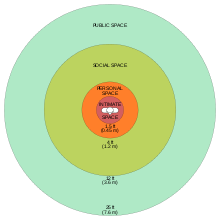Body language
Body language is a type of communication in which physical behaviors, as opposed to words, are used to express or convey information. Such behavior includes facial expressions, body posture, gestures, eye movement, touch and the use of space. The term body language is usually applied in regard to people but may also be applied to animals.[1] The study of body language is also known as kinesics.[2]
Although body language is an important part of communication, most of it happens without conscious awareness.
Body "language" must not be confused with sign language. Sign languages are literally languages: they have (their own) complex grammar systems, and they also are able to exhibit the fundamental properties that are considered to exist in all (true) languages.[3][4] Body language, on the other hand, does not have a grammar system and must be interpreted broadly, instead of having an absolute meaning corresponding with a certain movement, so it is not a language, and is simply termed as a "language" due to popular culture.[5]
In a society, there are agreed-upon interpretations of particular behavior. Interpretations may vary from country to country, or culture to culture. (On this note, there also is controversy on whether body language is universal.) Body language, a subset of nonverbal communication, complements verbal communication in social interaction. In fact, some researchers conclude that nonverbal communication accounts for the majority of information transmitted during interpersonal interactions.[6] It helps to establish the relationship between two people and regulates interaction, yet it can be ambiguous.
Facial expression is a part of body language and the expression of emotion. An accurate interpretation of it relies on interpreting multiple signs in combination – such as the movement of the eyes, eyebrows, lips, nose and cheeks – in order to form an impression of a person's mood and state of mind; it should always be additionally considered in regard to the context in which it is occurring and the person's likely intention.[7]
Whilst facial body language can be interpreted as a sign of genuine emotion, a lack of it may suggest a lack of sincerity. For example, a lack of wrinkles around the eyes suggests a potentially fake smile. At one point, researchers believed that making a genuine smile was nearly impossible to do on command. When someone is smiling joyfully they wrinkle around their eyes. When someone is faking it, they do not. If someone is trying to look happy but really is not, one will not see the wrinkles. More recently, however, a study conducted by researchers at Northeastern University found that people could convincingly fake a Duchenne smile, even when they were not feeling especially happy.[16]



